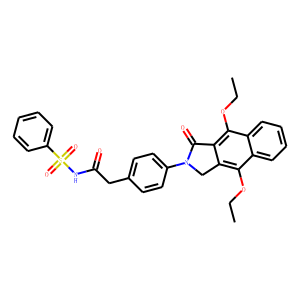| Reference | 1. Korean J Physiol Pharmacol. 2014 Aug;18(4):341-6. doi:
10.4196/kjpp.2014.18.4.341. Epub 2014 Aug 13.
<br>
Effects of lubiprostone on pacemaker activity of interstitial cells of cajal from
the mouse colon.
<br>
Jiao HY(1), Kim DH(2), Ki JS(1), Ryu KH(1), Choi S(1), Jun JY(1).
<br>
Author information: <br>
(1)Department of Physiology, College of Medicine, Chosun University, Gwangju
501-759, Korea.
(2)Department of Radiology, College of Medicine, Chosun University, Gwangju
501-759, Korea.
<br>
Lubiprostone is a chloride (Cl(-)) channel activator derived from prostaglandin
E1 and used for managing constipation. In addition, lubiprostone affects the
activity of gastrointestinal smooth muscles. Interstitial cells of Cajal (ICCs)
are pacemaker cells that generate slow-wave activity in smooth muscles. We
studied the effects of lubiprostone on the pacemaker potentials of colonic ICCs.
We used the whole-cell patch-clamp technique to determine the pacemaker activity
in cultured colonic ICCs obtained from mice. Lubiprostone hyperpolarized the
membrane and inhibited the generation of pacemaker potentials. Prostanoid EP1,
EP2, EP3, and EP4 antagonists (SC-19220, PF-04418948, 6-methoxypyridine-2-boronc
acid N-phenyldiethanolamine ester, and GW627368, respectively) did not block the
response to lubiprostone. L-NG-nitroarginine methyl ester (L-NAME, an inhibitor
of nitric oxide synthase) and 1H-[1,2,4]oxadiazolo[4,3,-a]quinoxalin-1-one (ODQ,
an inhibitor of guanylate cyclase) did not block the response to lubiprostone. In
addition, tetraethylammonium (TEA, a voltage-dependent potassium [K(+)] channel
blocker) and apamin (a calcium [Ca(2+)]-dependent K(+) channel blocker) did not
block the response to lubiprostone. However, glibenclamide (an ATP-sensitive K(+)
channel blocker) blocked the response to lubiprostone. Similar to lubiprostone,
pinacidil (an opener of ATP-sensitive K(+) channel) hyperpolarized the membrane
and inhibited the generation of pacemaker potentials, and these effects were
inhibited by glibenclamide. These results suggest that lubiprostone can modulate
the pacemaker potentials of colonic ICCs via activation of ATP-sensitive K(+)
channel through a prostanoid EP receptor-independent mechanism.
<br>
2. Invest Ophthalmol Vis Sci. 2011 Jun 1;52(6):3506-13. doi: 10.1167/iovs.10-6510.
<br>
The role of the prostaglandin EP4 receptor in the regulation of human outflow
facility.
<br>
Millard LH(1), Woodward DF, Stamer WD.
<br>
Author information: <br>
(1)Medical Pharmacology Graduate Program, University of Arizona, Tucson, Arizona,
USA.
<br>
PURPOSE: Activation of prostaglandin (PG)-EP(4) receptors by 3,7-dithiaPGE(1)
robustly lowers intraocular pressure in nonhuman primate eyes, which increases
outflow facility but has no effect on aqueous secretion or uveoscleral outflow.
Because of differences in PG efficacy in outflow function between nonhuman
primates and humans, we tested the impact of 3,7-dithiaPGE(1) on conventional
outflow function in human donor eyes.<br>
METHODS: The expression pattern of PG-EP(4) receptors was determined in
corneoscleral tissues of human donor eyes and in cultures of human outflow cells
by immunofluorescence microscopy and Western blot, respectively. The efficacy of
3,7-dithiaPGE(1) was determined by assaying agonist-stimulated cAMP accumulation
and β-arrestin mobilization in cultured human cells. Agonist effects on outflow
facility were examined in paired human donor eyes that were perfused at 8 mm Hg
of constant pressure, equivalent to 15 mm Hg in vivo.<br>
RESULTS: The trabecular meshwork (TM) and Schlemm/’s canal (SC) cells expressed
PG-EP(4) receptors. Agonist-mediated effects on the PG-EP(4) receptors were
detected in SC (EC(50) = 6.3 × 10(-9) M, n = 4), but not TM (EC(50) = 1.7 ×
10(-7) M, n = 5) cells. Effects in SC cells were blocked by the PG-EP(4)
receptor-selective antagonist GW627368 (EC(50) = 1.09 × 10(-2) M, n = 4), but not
the PG-EP(2) receptor-selective antagonist AH6809 (EC(50) = 4.10 × 10(-9) M, n =
5). Perfused into human eyes at a concentration that selectively activates
PG-EP(4) receptors, 3,7-dithiaPGE(1) (10 nM) increased outflow facility by 51% ±
18% over baseline levels in individual drug-treated eyes after drug exchange (n =
6 eyes; P = 0.05) and by 69% ± 23% (P < 0.01) compared with that in contralateral
eyes.<br>
CONCLUSIONS: Activation of PG-EP(4) receptors expressed by SC cells of the human
conventional outflow pathway appears to contribute to PG regulation of outflow
facility.
<br>
3. Br J Pharmacol. 2011 Jan;162(2):508-20. doi: 10.1111/j.1476-5381.2010.01058.x.
<br>
Lubiprostone targets prostanoid EP₄ receptors in ovine airways.
<br>
Cuthbert AW(1).
<br>
Author information: <br>
(1)Department of Medicine, University of Cambridge, Addenbrooke/’s Hospital, UK.
[email protected]
<br>
BACKGROUND AND PURPOSE: Lubiprostone, a prostaglandin E₁ derivative, is reported
to activate ClC-2 chloride channels located in the apical membranes of a number
of transporting epithelia. Lack of functioning CFTR chloride channels in
epithelia is responsible for the genetic disease cystic fibrosis, therefore,
surrogate channels that can operate independently of CFTR are of interest. This
study explores the target receptor(s) for lubiprostone in airway epithelium.
EXPERIMENTAL APPROACH: All experiments were performed on the ventral tracheal
epithelium of sheep. Epithelia were used to measure anion secretion from the
apical surface as short circuit current or as fluid secretion from individual
airway submucosal glands, using an optical method.
KEY RESULTS: The EP₄ antagonists L-161982 and GW627368 inhibited short circuit
current responses to lubiprostone, while EP₁(,)₂(&)₃ receptor antagonists were
without effect. Similarly, lubiprostone induced secretion in airway submucosal
glands was inhibited by L-161982. L-161982 effectively competed with lubiprostone
with a K(d) value of 0.058 μM, close to its value for binding to human EP₄
receptors (0.024 μM). The selective EP₄ agonist L-902688 and lubiprostone behaved
similarly with respect to EP₄ receptor antagonists. Results of experiments with
H89, a protein kinase A inhibitor, were consistent with lubiprostone acting
through a G(s) -protein coupled EP₄ receptor/cAMP cascade.
CONCLUSIONS AND IMPLICATIONS: Lubiprostone-induced short-circuit currents and
submucosal gland secretions were inhibited by selective EP₄ receptor antagonists.
The results suggest EP₄ receptor activation by lubiprostone triggers cAMP
production necessary for CFTR activation and the secretory responses, a
possibility precluded in CF tissues.
<br>
|

